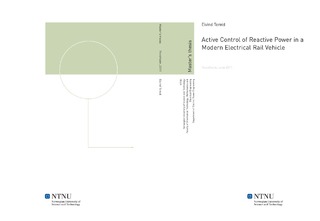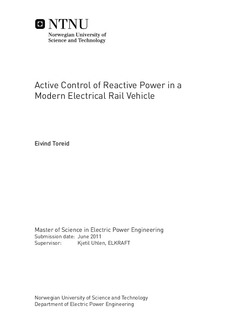| dc.contributor.advisor | Uhlen, Kjetil | nb_NO |
| dc.contributor.author | Toreid, Eivind | nb_NO |
| dc.date.accessioned | 2014-12-19T13:52:47Z | |
| dc.date.available | 2014-12-19T13:52:47Z | |
| dc.date.created | 2011-09-26 | nb_NO |
| dc.date.issued | 2011 | nb_NO |
| dc.identifier | 443558 | nb_NO |
| dc.identifier | ntnudaim:6073 | nb_NO |
| dc.identifier.uri | http://hdl.handle.net/11250/257103 | |
| dc.description.abstract | Modern electrical rail vehicles employ four-quadrant voltage source converters, which allow independent control of real and reactive power. This thesis focuses the control of reactive power at the vehicle regarding load flow and stability.Settings for power factor as a function of voltage were proposed in a project fall 2010, aiming to reduce line loss and increase transmission capacity. This thesis is mainly a further investigation of some of the settings proposed.One of the proposed settings for controlling reactive power is found to reduce the load of a rotary converter station in the range of 0-3 %. Total system losses are reduced by 0.21-0.33 %.During traction, the problematic issue regarding stability is found to be speed oscillations of the rotary converter. Controlling reactive power is found to have a limited damping effect on speed oscillations of a rotary converter. Other works have investigated how speed oscillations of the rotary converter can be damped by controlling the real power of the vehicle; the real power control is found to have a clearly better effect than reactive.During no-load operation, the problematic issue regarding stability is found to be oscillations caused by the vehicle and its control system. The vehicle control system and its response to the line voltage may cause instability, especially at long line lengths, regardless of any rotary converter. As reactive power has a significant effect on the line voltage, reactive power may be controlled in a manner increasing the damping of such oscillations significantly.Finally the thesis describes how a simulation model of a modern electrical rail vehicle for stability analysis can be made from the steady state characteristics and the input admittance of the vehicle, without knowing the complete vehicle model.The settings which where proposed and investigated in this project are optimized for a system fed by stiff voltage sources, not by rotary converters, and a more complete optimization for a system fed by rotary converters would be of interest. | nb_NO |
| dc.language | eng | nb_NO |
| dc.publisher | Institutt for elkraftteknikk | nb_NO |
| dc.subject | ntnudaim:6073 | no_NO |
| dc.subject | MSELPOWER Master of Science in Electric Power Engineering | no_NO |
| dc.subject | | no_NO |
| dc.title | Active Control of Reactive Power in a Modern Electrical Rail Vehicle | nb_NO |
| dc.type | Master thesis | nb_NO |
| dc.source.pagenumber | 155 | nb_NO |
| dc.contributor.department | Norges teknisk-naturvitenskapelige universitet, Fakultet for informasjonsteknologi, matematikk og elektroteknikk, Institutt for elkraftteknikk | nb_NO |

